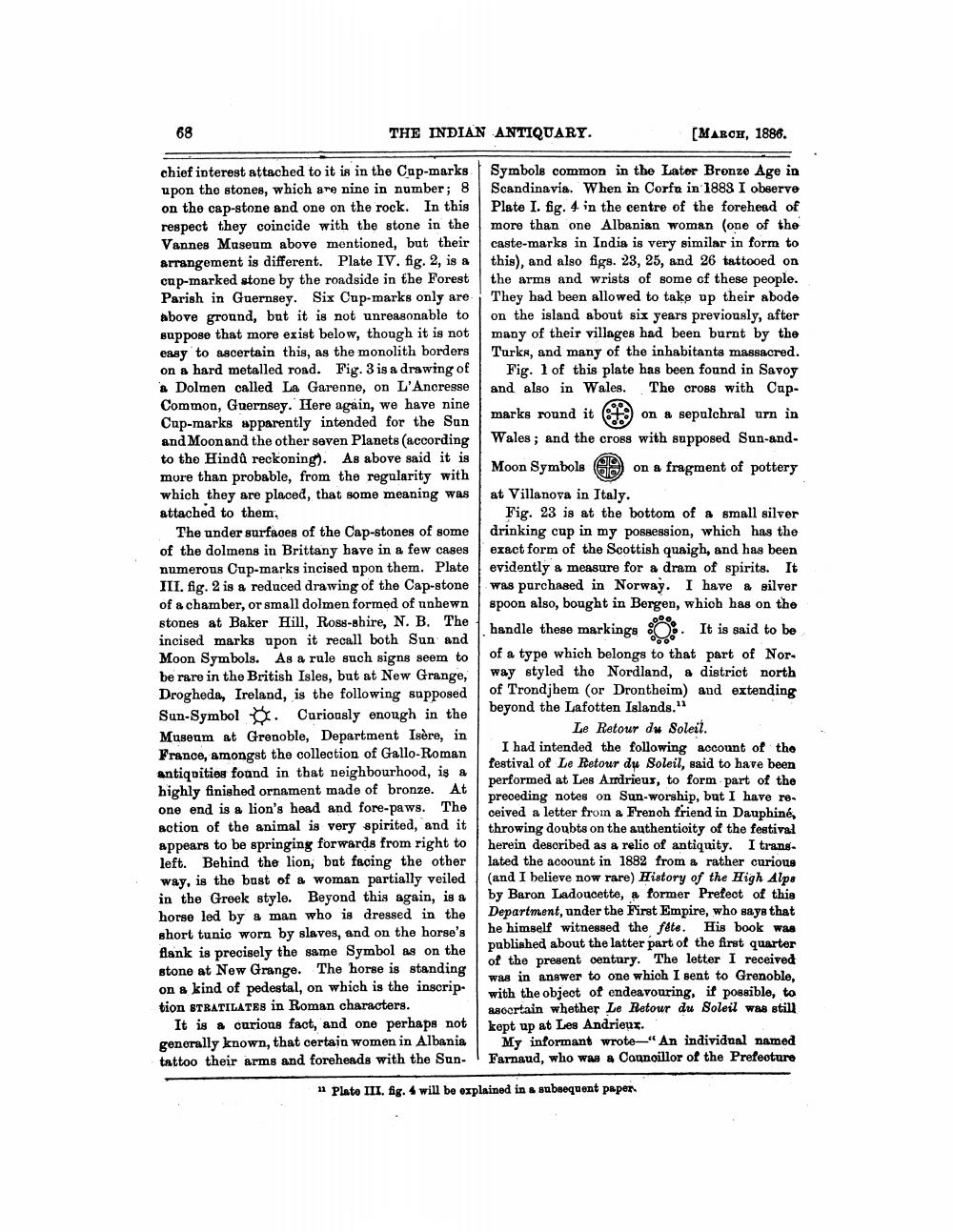________________
THE INDIAN ANTIQUARY.
(MARCH, 1886.
chief interest attached to it is in the Cap-marks upon the stones, which are nine in number; 8 on the cap-stone and one on the rock. In this respect they coincide with the stone in the Vannes Museum above mentioned, but their arrangement is different. Plate IV. fig. 2, is a cup-marked stone by the roadside in the Forest Parish in Guernsey. Six Cup-marks only are above ground, but it is not unreasonable to suppose that more exist below, though it is not easy to ascertain this, as the monolith borders on a hard metalled road. Fig. 3 is a drawing of
Dolmen called La Garenne, on L'Ancresse Common, Guernsey. Here again, we have nine Cup-marks apparently intended for the Sun and Moonand the other seven Planets (according to the Hindû reckoning). As above said it is more than probable, from the regularity with which they are placed, that some meaning was attached to them.
The under surfaces of the Cap-stones of some of the dolmens in Brittany have in a few cases numerous Cup-marks incised upon them. Plate III, fig. 2 is a reduced drawing of the Cap-stone of a chamber, or small dolmen formed of unhewn stones at Baker Hill, Ross-shire, N. B. The incised marks upon it recall both Sun and Moon Symbols. As a rule such signs seem to be rare in the British Isles, but at New Grange, Drogheda, Ireland, is the following supposed Sun-Symbol ☆ Curiously enough in the Museum at Grenoble, Department Isère, in France, amongst the collection of Gallo-Roman antiquities found in that neighbourhood, is a highly finished ornament made of bronze. At one end is a lion's head and fore-paws. The action of the animal is very spirited, and it appears to be springing forwards from right to left. Behind the lion, but facing the other way, is the bust of a woman partially veiled in the Greek style. Beyond this again, is a horso led by a man who is dressed in the short tunic worn by slaves, and on the horse's flank is precisely the same Symbol as on the stone at Now Grange. The horse is standing on a kind of pedestal, on which is the inscrip. tion STRATILATES in Roman characters.
It is a curious fact, and one perhaps not generally known, that certain women in Albania tattoo their arms and foreheads with the Sun.
Symbols common in the Later Bronze Age in Scandinavia. When in Corfu in 1883 I observe Plate I. fig. 4. in the centre of the forehead of more than one Albanian woman (one of the caste-marks in India is very similar in form to this), and also figs. 23, 25, and 26 tattooed on the arms and wrists of some of these people. They had been allowed to take up their abode on the island about six years previously, after many of their villages had been burnt by the Turks, and many of the inhabitants massacred.
Fig. 1 of this plate has been found in Savoy and also in Wales. The cross with Cupmarks round it 49 on a sepulchral urn in Wales; and the cross with supposed Sun-andMoon Symbols on a fragment of pottery at Villanova in Italy.
Fig. 23 is at the bottom of a small silver drinking cup in my possession, which has the exact form of the Scottish quaigh, and has been evidently a measure for a dram of spirits. It was purchased in Norway. I have a silver spoon also, bought in Borgen, which has on the .handle these markings O . It is said to be of a type which belongs to that part of Norway styled tho Nordland, a district north of Trondjhem (or Drontheim) and extending beyond the Lafotten Islands."
Le Retour du Soleil. I had intended the following account of the festival of Le Retour du Soleil, said to have been performed at Les Ardrieus, to form part of the preceding notes on Sun-worship, but I have received a letter from a French friend in Dauphiné, throwing doubts on the authenticity of the festival herein described as a relio of antiquity. I translated the account in 1882 from a rather curious (and I believe now rare) History of the High Alps by Baron Ladoucette, a former Prefect of this Department, under the First Empire, who says that he himself witnessed the fåte. His book was published about the latter part of the first quarter of the present century. The letter I received was in answer to one which I sent to Grenoble, with the object of endeavouring, if possible, to asocrtain whether Le Retour du Soleil was still kept up at Les Andrieur.
My informant wrote "An individual named Farnaud, who was a Caunoillor of the Prefecture
1 Plato III, fig. 1 will be explained in a subsequent paper




